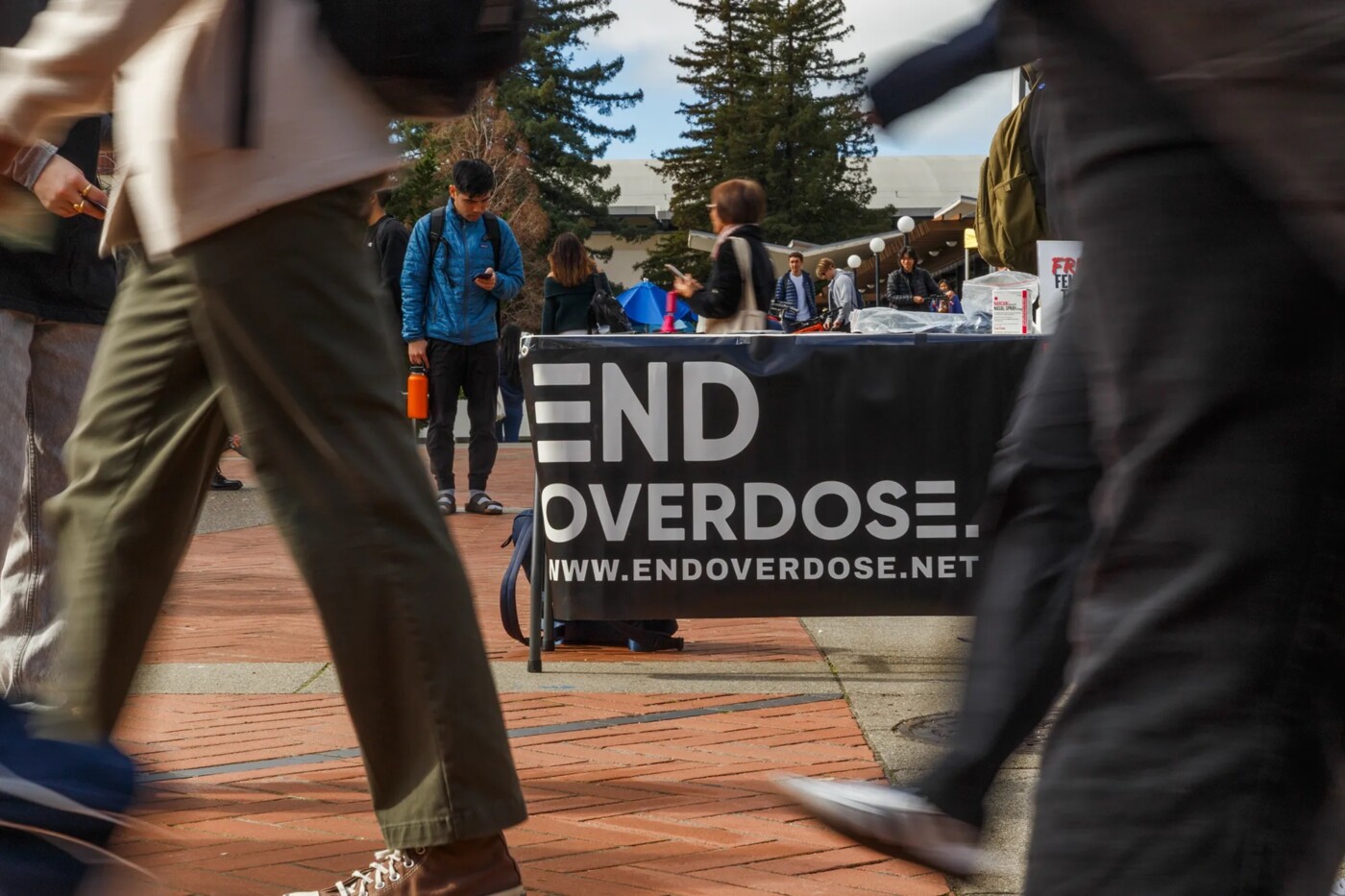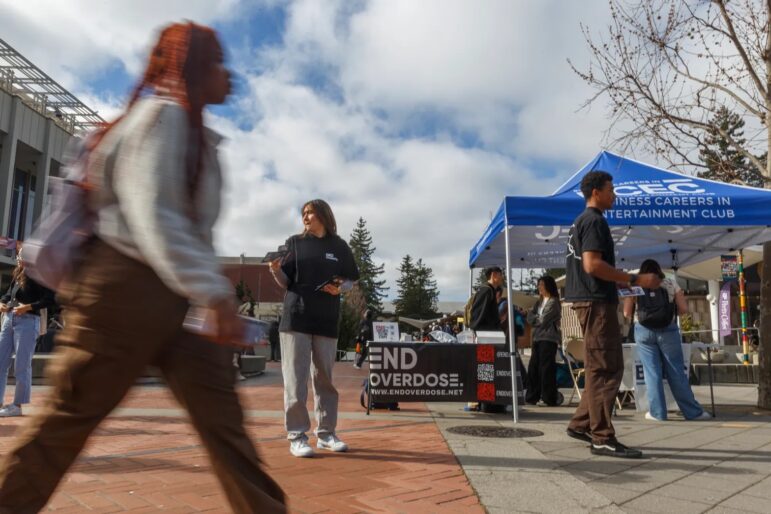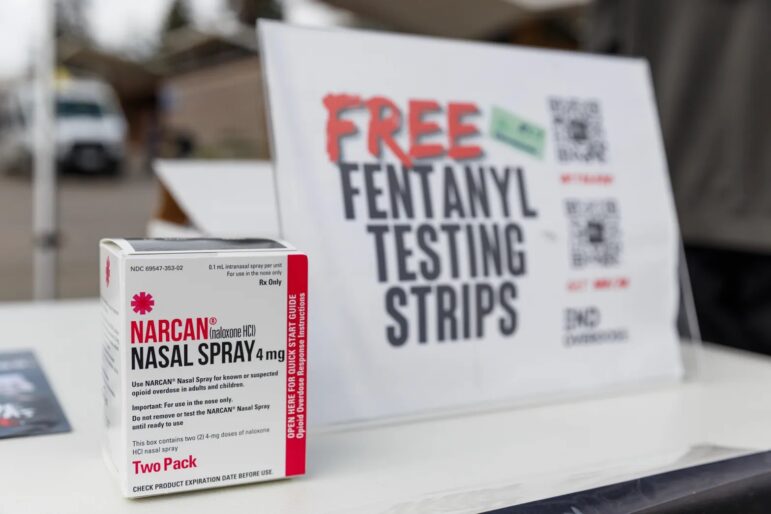When Mel McKernan moved in with her new roommate Braedon Ellis, they bonded quickly. Every night she would stay up until 1 a.m. just waiting for Ellis to get back from her job so they could watch TV together. McKernan, 19, was a second-year student at Seattle University. Ellis was 20 and working as a Domino’s delivery driver.
“She genuinely was the light of my life,” recalled McKernan, who has since transferred to UC Berkeley. “She had this beautiful purple hair. I felt like that was just an aura that she carried around with her.”
McKernan thought she had made a friend for life. The two young women lived with two other roommates in a beautiful waterfront house in Kenmore, Washington. But behind the walls, a darkness lurked. Their other roommates were addicted to fentanyl, an extremely potent synthetic opioid.
McKernan had braced herself for the possibility of losing a roommate. But she never expected it to be Ellis. Their magnetic connection severed when Ellis overdosed from a combination of drugs that included fentanyl.
“It completely changed my view on opioids,” McKernan said. “Because I was like, this could hit anyone. It can hit literally anyone.”

Fentanyl is now the leading cause of drug-related deaths nationwide. After a new wave of deadly overdoses among Californians 15 to 24 started to rise in 2019, lawmakers turned to California’s public colleges and universities to offer life-saving resources to its students.
The Campus Opioid Safety Act, which took effect Jan. 1, 2023, required campus health centers at most public colleges and universities to offer students free Narcan, a nasal spray that can reverse an opioid overdose.
Some colleges and universities have since armed students with Narcan, but not all have followed suit.
Today, when someone in the United States dies of a drug-related overdose, it’s usually linked to fentanyl. That’s a change from 20 years ago, when prescription opioids like OxyContin were the leading killer, according to Theo Krzywicki, founder and CEO of End Overdose, a national nonprofit based in Los Angeles aimed at eliminating drug-related overdose deaths, especially among teens and young adults.
“Fentanyl is a very different drug than OxyContin,” Krzywicki said. “The way people use it has changed.” Because fentanyl delivers a stronger and shorter-lived high than other opioids, people often use more of it, he said, and build up a tolerance to it quickly.
For years, the opioid epidemic hit middle-aged Californians harder, but the new wave brought on a rise in death rates for teens and young adults.
By 2021, teens 15 to 19 were five times as likely to die from an opioid overdose compared to 2019. For 20- to 24-year-olds, they were over three times as likely. Rates for adults between 25 and 75 years old, meanwhile, roughly doubled in the same time frame.
Recently, opioid-related fatalities among the state’s young people have started to reverse. While death rates for adults 25 and over continue to rise, rates have declined for people under 25. Since 2021, per-capita rates for opioid-related overdose deaths dropped by over a third for Californians 15 to 19 and 20 to 24.
Rising awareness could be what’s driving the recent decline, according to a statement from the Los Angeles County Department of Public Health. College-aged students increasingly use social media to spread information about the risks of fentanyl and where to find life-saving resources such as Narcan. Young people also tend to have stronger support systems and are less likely to use drugs alone, according to the statement.
Melissa Hurtado, a Democratic Central Valley state senator, introduced the Campus Opioid Safety Act, or SB 367, in February of 2021. She said she chose to target college campuses after hearing story after story of young people overdosing in her district.
“It was just such a serious threat,” Hurtado said. “And it still is.”

This January, another law, AB 461, went into effect that added fentanyl test strips to the requirements. The small paper strips can be used by drug users to check if their supply contains fentanyl. Counterfeit prescription pills, made to look like OxyContin or Adderall, often contain fentanyl, according to the U.S. Drug Enforcement Administration.
The act requires campus health centers at California State University campuses and community colleges to order free Narcan through a state program called the Naloxone Distribution Project. Schools also must educate their students about preventing overdoses, and let them know where they can find opioid overdose reversal medication. The law “requests” the University of California system to do the same, stopping short of a requirement because of the system’s constitutional autonomy.
At least 100 public colleges in California have Narcan somewhere on campus, according to data from the state distribution project that included a list of all applications from colleges and universities. Although not required by law, some private universities like Stanford also offer Narcan to students.
Every UC and Cal State has ordered Narcan from the state distribution project in the last two years, with the exception of CSU Maritime Academy. However, CSU Maritime said in an email statement that Narcan is available through their student health center.
Fourteen of California’s 72 physical community college districts were not represented in the data, but Narcan could still be on those campuses. Victor Valley College, in San Bernardino County, ordered Narcan through its police department, so the request was categorized as law enforcement. DeAnza College in Santa Clara County received its supply of Narcan from the county health department, according to college spokesperson Marisa Spatafore.
Hurtado represents much of Kern County, one of the deadliest counties for opioid-related overdoses among young people. In 2022, 15- to 19-year-olds in Kern County fatally overdosed on opioids at a rate three times higher than the statewide rate for the same age group, according to the California Department of Public Health. For 20- to 24-year-olds, the rate was twice as high.
The county is home to Cal State Bakersfield, whose health education department has given out about 60 boxes of Narcan to its students since January 2023. After completing a short online training, students can drop by the campus health clinic to pick up the opioid reversal drug.
Lauren Hedlund, a health educator at Cal State Bakersfield, said her team gets the word out to students through tabling, activities, and flyers. They also bring Narcan directly to classrooms if an instructor requests it. The instructor shows the training video beforehand, then the health education team visits the class to answer questions and hand out Narcan.
“It’s just making sure that I can reach as many students as possible so that they’re aware,” Hedlund said. She added that even if a student never needs the resources, they could know someone who does.
More than a year after the law went into effect, some colleges have yet to put Narcan in the hands of students. Elsewhere in Kern County, community colleges in Taft, Ridgecrest, and Bakersfield do not have a program for distributing Narcan to students. Bakersfield College is currently working on setting up a vending machine that would stock Narcan, menstrual products, and other health items, according to Marissa Perez, a medical assistant at the college.
In the East Bay Area, Peralta Community College District received Narcan from the state early last year, but until recently, no efforts were made to make it available through the student health center.
The district initially distributed the Narcan to its security staff. No Narcan trainings have been held for students, although the safety department held a training this year at an event for college employees.
Students can request a single packaged dose of Narcan through the district’s public safety office, according to a Feb. 14 announcement sent by associate director of public safety Amy Marshall. The email was sent to employees, but not to students. Marshall informed CalMatters via email that the health center received Narcan on Feb. 20. However, the district’s associate vice chancellor of educational services, Tina Vasconcellos, clarified in an email to CalMatters that the Narcan would be for health center staff to use within the clinic, and that they would not distribute Narcan to students.
A spokesperson from Hurtado’s office confirmed that even if a college has Narcan somewhere on campus, the school needs to offer it to students to comply with the law.
Crushed after losing her close friend, McKernan dropped out of Seattle University and took a year off college to stay home in Sacramento. Now 21, she’s finding her footing as a transfer student at UC Berkeley, where she majors in social welfare. She’s fervent about spreading harm reduction resources like Narcan, destigmatizing addiction, and addressing the deeper systemic issues that lead to addiction.
At her former university, McKernan had tried to organize her fellow students around overdose prevention, but struggled to find enough volunteers. So when she saw students from End Overdose’s UC Berkeley chapter handing out fentanyl test strips in Sproul Plaza on a recent afternoon, she asked immediately if she could join, offering to share infographics she’d made for social media.
Before her roommate’s death, she knew her household would benefit from Narcan, but she didn’t find out where to access it in time. “A lot of people, including myself, just learn about it too late,” McKernan said.
Tyler Mahomes, a legal studies major at UC Berkeley, founded the chapter of End Overdose last year. It’s one of the organization’s many college chapters across the United States, where students spread overdose prevention awareness and resources to fellow students. Mahomes’ team brings Narcan directly to fraternities and other student groups, and works with his university to patch holes in their harm reduction efforts. For example, he notified the university when his dorm hadn’t been restocked with overdose safety kits containing Narcan.
The students can even go where the university cannot. Last fall, the chapter volunteered at the Portola Music Festival in San Francisco to hand out Narcan to festival-goers.
Students are receptive to End Overdose’s peer-to-peer, non-judgemental approach. “They don’t see us as this administrative force,” Mahomes said. “We’re students like them [...] so they feel very comfortable.”
The approach has already seen some results. According to Mahomes, one student at a frat party recovered from an overdose after someone used Narcan provided by End Overdose.
Ellis, the purple-haired light of McKernan's life, left behind her mother and an 8-year-old brother when fentanyl took her life. Her mother, Dionne Waltz, would find out two days later, while driving to pick her son up from school.
Ellis was a “fireball,” Waltz recalled. She still misses her daughter’s kind and generous spirit. When they went out for coffee, Ellis would insist on covering the tab, even paying for the car behind them. Even though she didn’t make a lot of money, she’d always save up to buy her little brother something nice for Christmas.
Two years later, the initial shock has faded. Waltz still grieves her only daughter. But she sees flickers of her spark everywhere: in the sunsets, in the birds, and in anything bright pink, one of Ellis’ favorite colors.
“On the inside there’s that hollow echo all the time,” Waltz said. “I think about her every single day.”

When Ellis’ spark went out, another was lit. McKernan vowed not to lose another friend to an overdose. She believes that just starting a conversation about Narcan could save others.
“Because if you're educated and you're prepared, it’s so much less likely that you're going to lose a life to overdose,” McKernan said.
Khan is a fellow with the CalMatters College Journalism Network, a collaboration between CalMatters and student journalists from across California. This story and other higher education coverage are supported by the College Futures Foundation.


